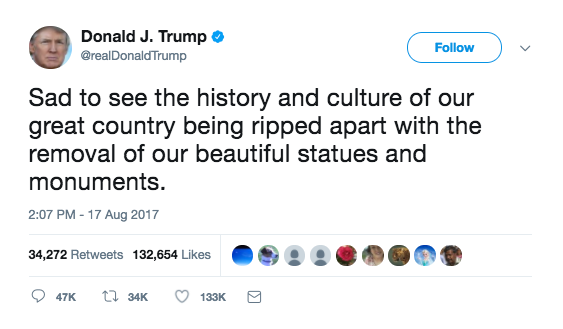
Watching footage of protesters in Durham, North Carolina pulling down a statue to a Confederate soldier could not but remind viewers of similar scenes played out at moments of turmoil. We have seen it recently at the University of Cape Town in South Africa with a campaign to remove the statue of Cecil Rhodes, the British colonialist and progenitor of apartheid, In 2013 we had the toppling of Lenin’s statue in Kiev, the destruction of Sadam Hussein’s in Baghdad in 2003, and if we look back further to how the statues of Europe’s arch white supremacists, the Nazis, were treated after the war, then we can see how, in 1946, the allied forces took a very different approach to what constitutes history and culture than the current Commander-in-Chief in the USA. (See also a column by my colleague Philip Seargeant in The Huffington Post for another take on this.)
Doubtless there will have been many people who found the removal of such monuments as ‘sad’ as Donald Trump did in the case of the Confederate soldier. So is it ever okay to pull down statues? Exploring this question the American poet and historian Kelly Grovier points out that such acts of iconoclasm have a long history and cites a case from 1357 when officials in Siena voted to remove a nude sculpture of Venus following a defeat on the battlefield for which they blamed the pagan seductress. Grovier argues that whilst art historians may regret this ‘missing puzzle piece in the evolution of image-making’, the record of its destruction is also a significant piece of evidence about ‘the unfolding consciousness of a people’.
The odd thing about statues is that whilst they are intended in some senses to freeze a moment in time and may indeed seem timeless they are, of course, not. They are made at particular point in time within specific historical contexts. The Confederacy statues are a prime example of this. A report by the Southern Poverty Law Center shows that the majority of Confederacy memorials were erected long after the Civil War and at times when racism was on the rise, particularly between 1895-1915 when the Jim Crow Laws legalizing segregation were in full force and the Ku Klux Klan were at their most powerful. Yes, they commemorated the Confederate dead, but they were also living reminders of white supremacism. As my late Open University colleague, the geographer Doreen Massey reminds us, in her book For Space, ‘If time unfolds as change then space unfolds as interaction… it is the sphere of the continuous production and reconfiguration of heterogeneity in all its forms – diversity, subordination, conflicting interests.’ In other words, it’s where we see and, work out our differences. That ‘working out’ can sometimes be a messy and even bloody business, as we saw in Charlottesville when a white supremacist drove his car into a crowd of people, leaving many injured and Heather Heyer dead. Surely a far more serious act of violence than pulling down a statue?
The crucial point is this: whilst statues are one way we seek to set historical narratives in stone, like all stories there are different angles from which they can be told and read. When a statue goes up, there is likely to a be a dominant version of the history it tells, but time can change how we read that story and at such points the statue acts as a collision point for the different discordant discourses it evokes. At such times, ‘place is an event’, as Doreen Massey put it. It is at moments such as these when our frozen history is thawed by the fire of contemporary debate and the statues, like Shakespeare’s Hermione, come to life, they tell their tales anew and we learn to see them from a fresh perspective. When people pull down statues they are not so much ending history as writing its next act. As William Faulkner memorably wrote in Requiem for a Nun, ‘The past is never dead. It’s not even past.’
When we look on monuments we should perhaps always be mindful of the words of Shelley’s ‘traveller from an antique land’ in Ozymandias, who said:
Two vast and trunkless legs of stone
Stand in the desert. . . . Near them, on the sand,
Half sunk a shattered visage lies, …
And on the pedestal, these words appear:
My name is Ozymandias, King of Kings;
Look on my Works, ye Mighty, and despair!
Nothing beside remains. Round the decay
Of that colossal Wreck, boundless and bare
The lone and level sands stretch far away.”
When Donald Trump weeps for the fallen Confederate soldier he is, perhaps, secretly weeping for himself, mindful of a day when his own statue may be pulled down (though probably not this one).